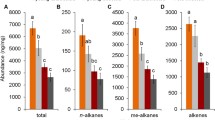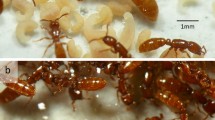Abstract
In bumblebees all species of the subgenus Psithyrus are social parasites in the nests of their Bombus hosts. In the bumblebee B. terrestris we investigated how colony size influences survival rates of nest entering females of the social parasite Psithyrus vestalis. Furthermore, we studied whether the host worker’s dominance status and age are reflected in its individual scent and whether Psithyrus females use volatiles to selectively kill host workers. The survival rate of Psithyrus vestalis females drops from 100%, when entering colonies with five workers, to 0% for colonies containing 50 host workers. Older host workers, born before the nest invasion, were selectively killed when Psithyrus females entered the nest. In contrast, all workers born after the nest invasion survived. The host workers’ dominance status and age are reflected by their individual odours: newly emerged workers produced a significantly lower total amount of secretions than 4-day-old workers. In chemical analyses of female groups we identified saturated and unsaturated hydrocarbons, aldehydes, and unsaturated wax-type esters of fatty acids. In a discriminant function analysis different worker groups were mainly separated by their bouquets of hydrocarbons. Killed workers release significantly more scent and of a different chemical composition, than survivors. Survivors alter scent production and increase it beyond the level of the killed workers within 1 day of the invasion. The Psithyrus female clearly maintains reproductive dominance utilizing these differences in the odour bouquets as criteria for killing workers that compete for reproduction.





Similar content being viewed by others
References
Alaux C, Savarit F, Jaisson P, Hefetz A (2004) Does the queen win it all? Queen–worker conflict over male production in the bumblebee, Bombus terrestris. Naturwissenschaften 91(8):400–403 (4)
Ayasse M, Engels W, Hefetz A, Tengö J, Lübke G, Francke W (1993) Ontogenetic patterns of volatiles identified in Dufour’s gland extracts from queens and workers of the primitively eusocial halictine bee, Lasioglossum malachurum (Hymenoptera: Halictidae). Insect Soc 40:41–58
Ayasse M, Marlovits TC, Tengö J, Taghizadeh T, Francke W (1995) Are there pheromonal dominance signals in the bumblebee Bombus hypnorum L (Hymenoptera, Apidae). Apidologie 26(1):163–180
Ayasse M, Engels W, Lübke G, Francke W (1999) Mating expenditures reduced via female sex pheromone modulation in the primitively eusocial halictine bee, Lasioglossum (Evylaeus) malachurum (Hymenoptera: Haltictidae). Behav Ecol Sociobiol 45:95–106
Backhaus K, Erichson B, Flinke W, Schuchard-Ficher C, Weiber R (1987) Multivariate Analysemethoden. Springer, New York
Benjamini Y, Hochberg Y (1995) Controlling the false discovery rate: a practical and powerful approach to multiple testing. J R Stat Soc 57(1):289–300
Benton T (2006) Bumblebees. Collins, London
Breed MD (1998) Recognition pheromones of the honey bee. Bioscience 48(6):463–470
Breed M, Diaz P, Lucero K (2003) Olfactory information processing in honeybee, Apis mellifera, nestmate recognition. Anim Behav 68:921–928
Breed MD, Perry S, Bjostad LB (2004) Testing the blank slate hypothesis: why honey bee colonies accept young bees. Insect Soc 51:12–16
Cartar RV, Dill LM (1991) Costs of energy shortfall for bumble bee colonies: predation, social parasitism, and brood development. Can Entomol 123(2):283–293
Cederberg B (1983) The role of trail pheromones in host selection by Psithyrus rupestris (Hymenoptera, Apidae). Ann Entomol Fenn 49:11–16
Dahbi A, Cerda X, Lenoir A (1998) Ontogeny of colonial hydrocarbon label in callow workers of the ant Cataglyphis iberica. C R Acad Sci Paris 321:395–402
Dani F, Jones G, Corsi S, Beard R, Pradella D, Turilazzi S (2005) Nestmate recogniton cues in the honey bee: differential importance of cuticular alkanes and alkenes. Chem Sens 30:1–13
Dronnet S, Simon X, Verhaeghe JC, Rasmont P, Errard C (2005) Bumblebee inquinilism in Bombus (FernaldaePsithyrus) sylvestris (Hymenoptera, Apidae): behavioural and chemical analyses of host–parasite interactions. Apidologie 36:59–70
Duchateau MJ (1989) Agonistic behaviours in colonies of the bumblebee Bombus terrestris. Dissertation, University of Utrecht, 77–98
Duchateau MJ, Velthuis HHW (1988) Development and reproductive strategies in the bumble bee, Bombus terrestris. Behaviour 107:186–207
Fisher RM (1983) Recognition of host nest odour by the bumble bee social parasite Psithyrus ashtoni (Hymenoptera: Apidae). J N Y Entomol Soc 91:503–507
Fisher RM (1984a) Dominance by a bumble bee social parasite (Psithyrus citrinus) over workers of its host (Bombus impatiens). Anim Behav 32(1):304–305
Fisher RM (1984b) Evolution and host specificity: a study of the invasion success of a specialized bumblebee social parasite. Can J Zool 62:1641–1644
Fisher RM (1985) Evolution and host specificity: dichotomous invasion success of Psithyrus citrinus (Hymenoptera: Apidae), a bumblebee social parasite in colonies of its two hosts. Can J Zool 63:977–981
Fisher RM (1987a) Queen-worker conflict and social parasitism in bumble bees (Hymenoptera: Apidae). Anim Behav 35:1026–1036
Fisher RM (1987b) Temporal dynamics of facultative social parasitism in bumble bees (Hymenoptera: Apidae). Anim Behav 35:1628–1636
Fisher RM (1988) Observations on the behaviours of three European cuckoo bumble bee species. Insectes Soc 35(4):341–354
Fisher RM, Sampson BJ (1992) Morphological specializations of the bumble bee social parasite Psithyrus ashtoni (Cressson) (Hymenoptera: Apidae). Can Entomol 124:69–77
Fisher RM, Greenwood DR, Shaw GJ (1993) Host recognition and the study of a chemical basis for attraction by cuckoo bumble bees (Hymenoptera: Apidae). J Chem Ecol 19(4):771–786
Fletcher DJC, Ross KG (1985) Regulation of Reproduction in Eusocial Hymenoptera. Annu Rev Entomol 30:319–343
Free JB, Weinberg I, White A (1969) The egg-eating behaviour of Bombus lapidarius. Behaviour 35(1969):313–317
Frehn E, Schwammberger KH (2001) Social parasitism of Psithyrus vestalis in free-foraging colonies of Bombus terrestris (Hymenoptera: Apidae). Entomol Gener 245:103–105
Hefetz A, Taghizadeh T, Francke W (1996) The exocrinology of the queen bumble bee Bombus terrestris (Hymenoptera: Apidae, Bombini). Z Naturforsch 51c:409–422
Hölldobler B, Michener CD (1980) Mechanisms of identification and discrimination in social hymenoptera. In: Markl H (ed) Evolution of social behaviour hypotheses and empirical tests. Verlag Chemie GmbH, Weinheim, pp 35–58
Kirchner WH, Röschard J (1999) Hissing in bumblebees: an interspecific defense signal. Insectes soc 46:239–243
Küpper G (1996) Psithyrus sylvestris (Lep.) in Völkern von Bombus pratorum (L.) (Hymenoptera: Apidae). Dissertation, Universität Bochum
Küpper G, Schwammberger KH (1995) Social parasitism in bumble bees (Hymenoptera, Apidae): observations of Psithyrus sylvestris in Bombus pratorum nests. Apidologie 26:245–254
Liebig J, Peeters C, Oldham NJ, Markstädter C, Hölldobler B (2000) Are variations in cuticular hydrocarbons of queens and workers a reliable signal of fertility in the ant Harpegnathos saltator? PNAS 97(8):4124–4131
Monin T (2006) Chemical recognition of reproductive status in social insects. Ann Zool Fenn 43:515–530
Norusis MJ (1993a) SPSS for Windows: base system user’s guide, release 6.0. SPSS, Chicago
Norusis MJ (1993b) SPSS for Windows: professional statistics, release 6.0. SPSS, Chicago
Pouvreau A (1973) Les enemies des bourdons. I. Etude d’une zooce¨ nose: le nid des bourdons. Apidologie 4:103–148
Röseler PF, van Honk CGJ et al (1990) Castes and reproduction in bumblebees. In: Engels W (ed) Social Insects, an evolutionary approach to castes and reproduction. Springer, Berlin, pp 147–166
Sick M (1993) Auffinden und olfaktorisches Erkennen von Wirtsnestern durch Kuckucksbienen (Gattung Sphecodes: Halictidae) und deren verwandtschaftliche Beziehungen zu den Wirtsbienen. Dissertation, Eberhard – Karl Universität Tübingen
Sick M, Ayasse M, Tengö J, Engels W, Lübke G, Francke W (1994) Host–parasite relationships in six species of Sphecodes bees and their halictid hosts: nest intrusion, intranidal behaviour and Dufour‘s gland volatiles (Hymenoptera: Halictidae). J Insect Behav 7(1):101–117
Sladen FWL (1912) The humblebee—its life-history and how to domesticate it. Mac Millan, London
Soroker V, Vienne C, Hefetz A, Nowbahari E (1994) The postpharyngeal gland as a “gestalt” organ for nestmate recognition in the ant Cataglyphis niger. Naturwissenschaften 81:510–513
Sramkova A, Schulz C, Twele R, Francke W, Ayasse M (2008) Fertility signals in the bumblebee Bombus terrestris (Hymenoptera: Apidae). Naturwissenschaften 95(6):515–522
Tengö J, Hefetz A, Bertsch A, Schmitt U, Lübke G, Francke W (1991) Species specificity and complexity of Dufour’s gland secretion of bumble bees. Comp Biochem Physiol 99B:641–646
Tengö J, Sick M, Ayasse M, Engels W, Svensson B, Lübke G, Francke W (1992) Species specificity of Dofour’s Gland Morphology and Volatile Secretions in Kleptoparasitic Sphecodes Bees (Hymenoptera: Halictidae). Biochem Syst Ecol 20(4):351–362
Van Doorn A, Heringa J (1986) The ontogeny of a dominance hierarchy in colonies of the bumblebee Bombus terrestris. Insectes Soc 33:3–25
Van Honk CG, Röseler PF, Velthuis HHW, Malotaux ME (1981a) The conquest of a Bombus terrestris colony by a Psithyrus vestalis female. Apidologie 12:57–67
Van Honk CG, Velthuis HHW, Röseler PF, Malotaux ME (1981b) The mandibular glands of Bombus terrestris queens as a source of queen pheromones. Ent Exp Appl 28:191–198
Wcislo WT (1986) Host nest discrimination by a cleptoparasitic fly, Metopia campestris (Fallén) (Diptera: Sarcophagidae: Miltogramminae). J Kans Entomol Soc 59:82–88
Zimma BO, Ayasse M, Tengö J, Ibarra F, Schulz C, Francke W (2003) Do social parasitic bumblebees use chemical weapons? (Hymenoptera: Apidae). Comp Physiol A 189:769–775
Zimma B, Ayasse M, Tengö J, Ibarra F, Francke W (2004) The role of semiochemicals in the reproductive biology of parasitic bumblebees. Mitt Dtsch Ges Allg Angew Entomol 14:195–198
Acknowledgments
We wish to thank Dr. Stefan Jarau for his valuable feedback in proofreading of the manuscript. Dr. Robert Hodgkison helped to revise the English. Anna Sramkova would like to thank the Friedrich Naumann Stiftung for financial support. We thank the German Research Foundation (DFG) for financial support (AY 12/2-1). All experiments comply with the current laws of the country in which they were performed: in this case, Germany.
Author information
Authors and Affiliations
Corresponding author
Rights and permissions
About this article
Cite this article
Sramkova, A., Ayasse, M. Chemical ecology involved in invasion success of the cuckoo bumblebee Psithyrus vestalis and in survival of workers of its host Bombus terrestris . Chemoecology 19, 55–62 (2009). https://doi.org/10.1007/s00049-009-0009-7
Received:
Accepted:
Published:
Issue Date:
DOI: https://doi.org/10.1007/s00049-009-0009-7




